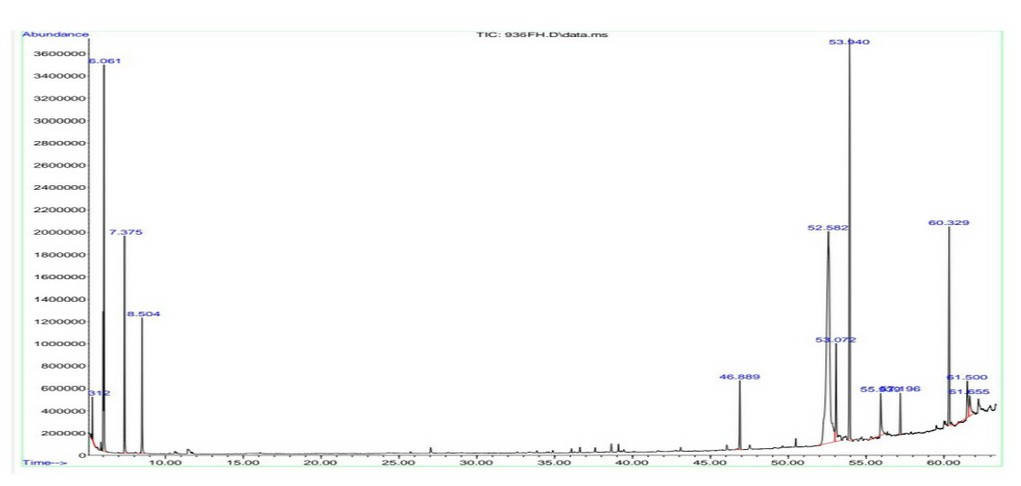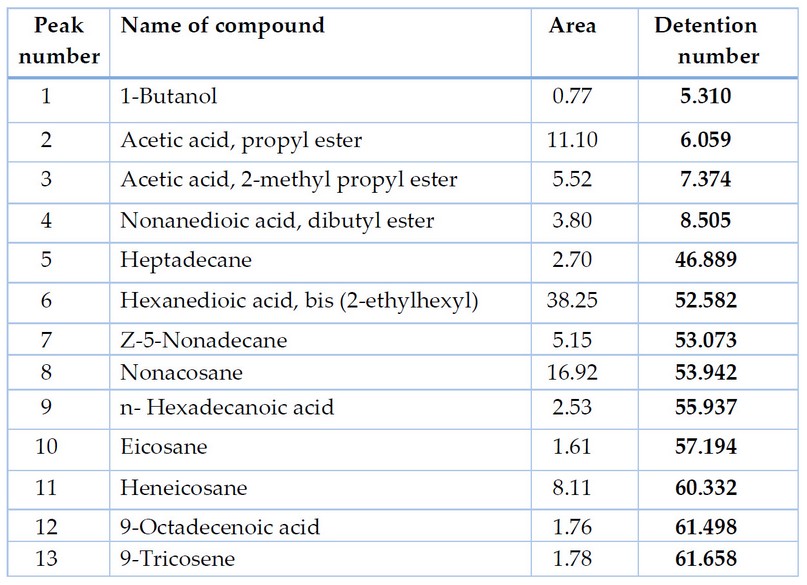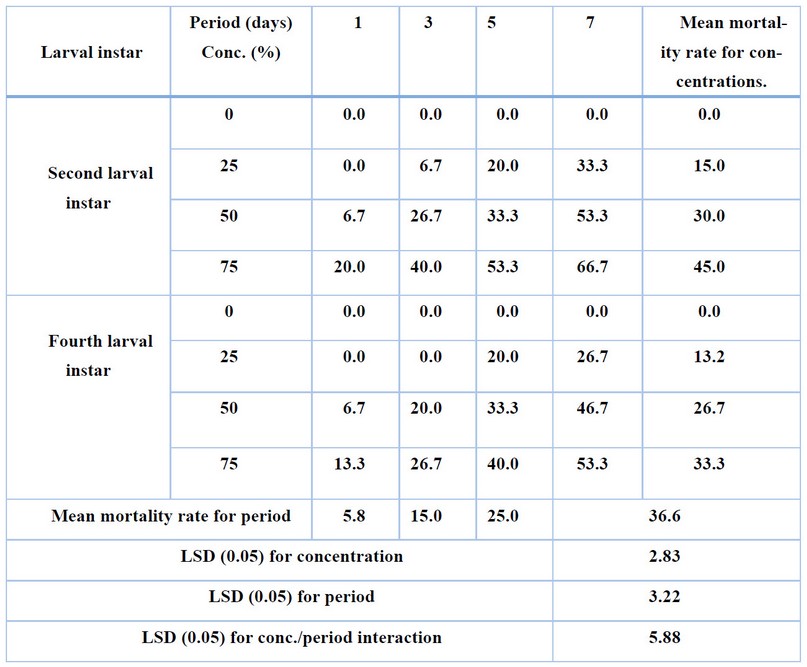2023.08.02.30
Files > Volume 8 > Vol 8 No 2 2023
Evaluation of the efficacy of Beauveria bassiana filtrate in controlling the beetle Everts Tragoderma granarium (Coleoptera: Dermestidae) in vitro
Farah Hadi Abdul Hussain1, and Yousef Dakhil Rashid2
1 Al-Musayyib Technical College/ Al-Furat Al-Awsat University
2 Al-Musayyib Technical College/ Al-Furat Al-Awsat University
*Correspondence: [email protected]
Available from: http://dx.doi.org/10.21931/RB/2023.08.02.30
ABSTRACT
The present study was performed to test the impacts of the fungus B. bassiana filtrate, at 25, 50, and 75% concentrations, on the larvae of the second and fourth instars of T. granarium. The study showed the superiority of the fungus filtrate at the concentration of 75% when treating the larvae of the second and fourth instars, with mortality rate values of 45.0% and 33.3%, respectively, after 7 days of treatment and diagnosis of several chemical compounds of different chemical groups for the filtrate fungus B .bassiana using the GC mass.
Keywords: Tragoderma ganarium; Beauveria bassiana; GC mass
INTRODUCTION
Stored materials, particularly those composed of cereal grains and their products, are of major importance to the food security of the entire global population, providing the necessary calories for daily consumption. Stored materials are among the main protein sources essential for human nutrition 1. The wheat species Triticum aestivum L. is among these crops, constituting one-third of the world's grain production. The importance of wheat lies in its nutritional value, being the main source of carbohydrates, including starch. One of the problems facing cultivating different crops in developing countries is the losses that occur after the harvest and during the storage period. These crops are exposed to damage due to infections with various warehouse pests 2. One of the most important pests that attack crops are the hairy grain beetle T. granarium Everts (Khabra), considered one of the most dangerous and pesticide-resistant insects 3. It attacks the stored grains and their products, which suffered tremendous damage due to their usage as food by the larvae. The infection is usually determined by the presence of the pest, whether adults or larvae and molting skins 4. To reduce the damages caused by this insect, several means were used, the chemical pesticides were the most common. But several problems have been encountered upon applying these pesticides, including the threats resulting from the residuals of pesticides or used chemicals and their economic cost. Therefore, Researchers have developed Modern methods, the latest of which was nano pesticides, to control stored pests 5. And among the other ways, biological control by entomopathogenic, one of the best alternatives to chemical pesticides, is safe, environmentally friendly, and has equal efficacy. The fungus Beauveria bassiana is a biological control agent used on a large scale to control insect stored such as Sitophilus granarius 6. This study aims to test the effects of crude filtrate of B. bassiana on some aspects of the biological performance of T. granarium beetle in vitro and to detect the active compounds in the filtrate by using the GC-mass technique
MATERIALS AND METHODS
Collection and breeding of T. granarium
The hairy grain beetles were obtained from the laboratories of the Ministry of Science and Technology, Baghdad, Iraq. Healthy wheat grains were cleaned of impurities and placed in the freezer for 72 hours at -20 ºC to ensure they were internally free from other insect infections. Ten adult beetle pairs of males and females were placed on 1 kg of healthy wheat grains with 5 g of dry yeast in plastic bottles of 100 ml volume and 10 cm diameter. The bottle opening was covered with organza fabric and sealed with a rubber band to prevent adults’ escape. The renewal of the culture was occasionally ensured 7. The insect was identified by an expert in the Natural History Research Center and Museum ̸ the University of Baghdad.
Preparation of Fungal Filtrates
The entomopathogenic fungus B. bassiana was obtained from the Laboratory of Insects, Department of biological control, Al-Furat Al-Awsat University; the funges were cultured on potato dextrose agar at 25 ± 1°C for 15 days before the initiation of the experiment. Two discs (7 mm diameter) were cut from the growing pathogen, placed in a sterile flask containing 500 mL of potato dextrose broth, and incubated at 27°C for 21 days. The filtrates were sterilized using the Millipore sterile filter (Millipore 0.45 μm syringe filter). The filtrate was considered a stock solution (100%) and then diluted to other concentrations by sterile distilled water. The control treatment was sterile distilled water only.
Gas Chromatography-Mass Spectrometry ( GC-MS) Analysis
To identify compounds of the filtrate of B.bassiana This analysis was performed by Instrument of Gas Chromatography-Mass spectrometry Shimadzu's in laboratories of the Ministry of Science and Technology – Baghdad.
Effects of B. bassiana filtrate on the mortality rate of the second and fourth larval instars
Three concentrations of the filtrate (25, 50, and 75%) were prepared by withdrawing a fixed volume of the filtrate through a sterile medical syringe and diluting it with different volumes of sterile distilled water. Twenty larvae from each stage were tested for each concentration, with three replicates, and compared to distilled water as control. For each replicate, 5 larvae were placed in a Petri dish, treated with the filtrate, and sprayed from a distance of 5 cm to ensure complete coverage. After spraying, the larvae were supplied with feeding, a wheat powder and a yeast mixture, as prepared previously. The dishes were incubated at a temperature of 30 ± 2 °C. The mortality rate was calculated after 1, 3, 5, and 7 days.
Statistical analysis
The results of the laboratory experiments were analyzed by applying the Complete Randomizd Design (CRD) according to the factorial experiments. The Less Significant Difference (LSD) test was used under the probability level of 0.05 to test the significance of the differences 8.
RESULTS
Figure 1 shows the most important active compounds separated from the filtrate of the fungus B. bassiana using the GC mass technique. Abdel-Wareth The results presented in this study are consistent with the findings of Abdel-Wareth 9, 10, who indicated that the filtrate of B. bassiana contains the compounds 9- octadecenoic acid, nonacosane, nonanedioic acid, and dibutyl ester, as identified by using the GC mass technique.

Figure 1. Identification of the active compounds in the crude filtrate of the fungus B. bassiana using the GG mass technique.

Table 1.
Effects of B. bassiana filtrate on the second and fourth instar larvae of T. granarium
Table 2 shows the superiority of B. bassiana filtrate at the concentration of 75%, which exerted the highest mortality rate of 45.0% for the second larval stage. In contrast, the lowest was 15.0% at the lowest concentration25%. The most increased mortality of the fourth larval stage was 33.3% at the concentration of 75%, whereas the lowest was 13.2% at the lowest concentration25%. It is noticed that the longer the period after the treatment with the filtrate, the higher the mortality rate, which reached values of 5.8, 15.0, 25.8, and 36.6% after 1, 3, 5, and 7 days, respectively. It was also noticed that the higher the concentration, the higher the mortality rate, which reached 30.0, 18.3, and 45.0% at concentrations of 25, 50, and 75%, respectively, for the second larval instar. For the fourth instar, the mortality rate values reached 13.2, 26.7, and 33.3% at 25, 50, and 75% concentrations, respectively. As for the concentration/period interaction treatment, the highest mortality rate for the second larval instar (66.7%) was recorded at the concentration of 75%, showing highly significant differences with the remainder of the treatments, where the lowest was 33.3% at the concentration of 25% concentration. As for the fourth larval instar, the highest mortality rate was 53.3% at 75% concentration, and the lowest was 26.7% at 25% concentration. However, the control treatment did not record any mortality. These results agree with the reported effectiveness of the fungal filtrate of B. bassiana, which is conferred by the active compounds shown in Figure 1 and Table 1.

Table 2. Effects of B. bassiana filtrate concentration on the mortality rate of the second and fourth larval instars of T. granarium.
DISCUSSION
These compounds are like those found in manufactured pesticides but with no effects on the environment. The cause of death is also attributed to the fact that the secondary metabolites of the fungus can interfere with the immune system, thus causing changes in the host's behavior. These changes include for example, reduced feeding, reduced activity, and paralysis of the insect, as well as changes in tissue structures and, thus, the rapid death of the host 11. Al-Shuwaili 12 utilized the filtrate of B. bassiana against the black bean aphid Aphis fabae, where the concentration of 100% of the filtrate caused mortality rates of 52.17 and 54.10% of nymphs and adults, respectively. These results agree with the study of Ghaylan 13, where the filtrate of B. bassiana caused the highest mortality rate. The mortality rate of Spodoptera litura larvae was 73.33% at 100% concentration. 14, 15, used Trichoderma harzianum filtrate against Aphis fabae nymphs, which showed the highest mortality rate of 71.81% at 100% concentration.
CONCLUSIONS
The results of the laboratory experiments were analyzed by applying the Complete Randomizd Design (CRD) according to the factorial experiments. The Less Significant Difference (LSD) test was used under the probability level of 0.05 to test the significance of the differences.
REFERENCES
1 Sherry, P.R.and Halford, N.G. Cereal seed storage proteins; structures, properties and role in grain utilization. Journal of Experimental Botany, 2007; 539(370);947-958.
2 Ismail, Iyad Youssef. Pests of stored materials. Mosul University, 2014;156 p.
3 Lowe,S.; Browne M.; Boudjelas S. and DePoorter, M. 100 of the word Invesive Alien Species:A Selection from the Global Invasive Species Database.Invesive Species Specialist Group,World Conservation Union(IUCN) . 2000.
4 Hagstrum, D.W. and Subramanyam B. Stored-Product Insect Resource. AACC International, St. Paul, Minnesota, USA, 2009; 509 pp.
5 Hilal, S. M.; Mohmed, A. S. ; Barry ,N. M. and Ibrahim, M. H. Entomotoxicity of TiO2 and ZnO Nanoparticles Against Adults Tribolium Castaneum (Herbest) (Coleoptera: Tenebrionidae). IOP Conf. Series: Earth and Environmental Science 910, doi:10.1088/1755-1315/910/1/012088. 2021.
6 Mantzoukas, S.; Lagogiannis, I.; Mpekiri, M.; Pettas, I.and Eliopoulos, P.A. Insecticidal Action of Several Isolates of Entomopathogenic Fungi against The Granary Weevil Sitophilus granarius. Agriculture , 2019; 9, 222. https://doi.org/10.3390/agriculture9100222
7 Al-Nuaimi, M. AT The effect of the fungus Metarhizium anisopliae and silver nanoparticles manufactured by it on the development of the hairy beetle Trogoderma granarium. PhD thesis. College of Women for Sciences, University of Baghdad. 2018; page 28.
8 Al-Rawi, K. M. and Khalaf Allah, A.M. Design and Analysis of Agricultural Experiments. Dar Al-Kutub for Printing and Publishing. University of Mosul, 488 pages. College of Education, Department of Biology. 1980.
9 Abdel-Wareth, Marwa T.A, Mosad A. Ghareeb ,Mohamed S. Abdel-Aziz and Ali M. El-Hagrassi. Snailicidal, antimicrobial, antioxidant and anticancer activities of Beauveria bassiana, Metarhizium anisopliae and Paecilomyces lilacinus fungal extracts . Egyptian Journal of Aquatic Biology & Fisheries . 2019; 23(2): 195 - 212
10 Abedalhammed, H. S., Naser, A. S., Al-Maathedy, M. H., Mohammed, Th. T., Jaber, B. T. & Al-Asha'ab, M. H. The effect of vitamin e as an antioxidant with different levels of dried tomato pomace supplementation on diets of common carp (cyprinus carpio l) on blood indices. Biochemical and Cellular Archives, 2020; 20(2): 5173-5176.
11 Charnley, A . K . Fungal Pathogens of Insects: Cuticle Degrading Enzymes and Toxins. Advances in Botanical Research. 2003;40: 241-321.
12 Al-Shuwaili, T. S. J. Evaluation of the efficiency of some biological and chemical factors in controlling the black bean aphid, Aphis phapae (Aphididae..Homoptera). Master's thesis. 2010; 73 pages.
13 Ghaylan, A. H. Y. and Al Masoudi, A. D. Biological resistance of Spodoptera litura (Fab.) using the filtrate of the fungus Beauveria bassiana. Babylon University Journal , Pure and Applied Sciences, 2013; 1(2).
14 Ohmayed, K. H. .; Sharqi, . M. M. .; Rashid, H. M. . Comparison Of The Physical And Chemical Changes In Local Organic Waste After Cultivation Of The Ganoderma Lucidum Mushroom And Composting By Common Methods. Journal of Life Science and Applied Research. 2020, 1, 1-9..
15 Al-Maathedy, M. H., Mohammed, Th. T. & Al-Asha'ab, M. H. The effect of vitamin e supplementation and different levels of dried tomato pomace on common carp diets (cyprinus carpio l.) on productive performance. Biochemical and Cellular Archives, 2020; 20(2): 5371-5377.
16 RELYEA, RA A cocktail of contaminants: how mixtures of Pesticides at low concentrations affect aquatic communities. Oecologia, 2009 ; 159: 363 – 376.
Received: 10 February 2023/ Accepted: 15 May 2023 / Published:15 June 2023
Citation: Hussain, F.H.A.; Rashid, Y.D. Evaluation of the efficacy of Beauveria bassiana filtrate in controlling the beetle Everts Tragoderma granarium (Coleoptera: Dermestidae) in vitro. Revis Bionatura 2023;8 (2) 30. http://dx.doi.org/10.21931/RB/2023.08.02.30
